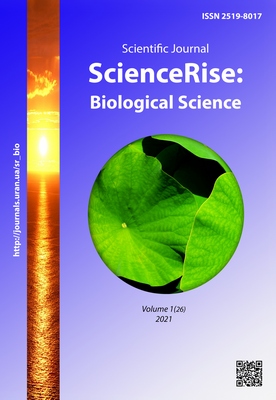Combined preparation based on chelating magnesium by phosphorylated casein. Characteristics of its syntesis
DOI:
https://doi.org/10.15587/2519-8025.2021.228758Keywords:
casein, magnesium, phosphorus, synthesis, hydrolysis, amino acids, phosphorylation, chelation, complexationAbstract
The article is devoted to the development and synthesis of a new drug for use in animal husbandry and veterinary medicine as an immunostimulatory and adaptogenic agent. The basis of the new drug is a combination of magnesium, phosphorus, and casein of cow's milk.
Given the important scientific and practical importance for veterinary medicine of innovative drugs that would have pronounced immunostimulatory and adaptogenic properties, the aim of our research is to develop a method of obtaining a new drug with an original composition and further studies of its effectiveness and safety.
Modern materials and methods were used to achieve this goal. In particular, mass spectrometry was used on a Waters H-class UPLC liquid high-pressure liquid chromatography spectrometer with a Waters TQ-S micro three-quadrupole detector; atomic emission spectrometer with inductively coupled plasma Analytik-Jena Plasma Quant PQ 9000 Elite; liquid chromatographer with a three-quadrupole mass detector and with analytical column – Waters ACQUITY UPLC BEH C18 1.7μm 2.1x50mm.
The result of the work was the development of a method of modification of the casein molecule, which was carried out in several stages: the first stage was the direct phosphorylation of the casein molecule; the second stage of the synthesis was the chelation of magnesium with casein.
Based on the results of this work, the following conclusions were formed: 1) the synthesis of a new drug is carried out in two stages: the first – modification of casein by direct phosphorylation and the second stage – chelation of magnesium with casein; 2) it was found that the efficiency of phosphorylation directly correlates with the number of treatment cycles of the reaction mixture and is optimal for three treatment cycles
References
- Egger, L., Ménard, O., Baumann, C., Duerr, D., Schlegel, P., Stoll, P. et. al. (2019). Digestion of milk proteins: Comparing static and dynamic in vitro digestion systems with in vivo data. Food Research International, 118, 32–39. doi: http://doi.org/10.1016/j.foodres.2017.12.049
- Kreipe, L., Deniz, A., Bruckmaier, R. M., van Dorland, H. A. (2011). First report about the mode of action of combined butafosfan and cyanocobalamin on hepatic metabolism in nonketotic early lactating cows. Journal of Dairy Science, 94 (10), 4904–4914. doi: http://doi.org/10.3168/jds.2010-4080
- Romani, A. M. P. (2013). Magnesium in Health and Disease. Interrelations Between Essential Metal Ions and Human Diseases, 49–79. doi: http://doi.org/10.1007/978-94-007-7500-8_3
- Ogrizek, M., Konc, J., Bren, U., Hodoscek, M., Janezic, D. (2016). Role of magnesium ions in the reaction mechanism at the interface between Tm1631 protein and its DNA ligand. Chemistry Central Journal, 10 (1). doi: http://doi.org/10.1186/s13065-016-0188-6
- Xiong, B., Wang, G., Zhou, C., Liu, Y., Li, J., Zhang, P., Tang, K. (2017). DCC-assisted direct esterification of phosphinic and phosphoric acids with O-nucleophiles. Phosphorus, Sulfur, and Silicon and the Related Elements, 193 (4), 239–244. doi: http://doi.org/10.1080/10426507.2017.1395438
- Atacan, K., Çakıroğlu, B., Özacar, M. (2017). Efficient protein digestion using immobilized trypsin onto tannin modified Fe 3 O 4 magnetic nanoparticles. Colloids and Surfaces B: Biointerfaces, 156, 9–18. doi: http://doi.org/10.1016/j.colsurfb.2017.04.055
- Hellman, U. (2000). Sample preparation by SDS/PAGE and in-gel digestion. Proteomics in Functional Genomics, 43–54. doi: http://doi.org/10.1007/978-3-0348-8458-7_3
- Zhang, Y., Sun, H., Zhang, J., Brasier, A. R., Zhao, Y. (2017). Quantitative Assessment of the Effects of Trypsin Digestion Methods on Affinity Purification–Mass Spectrometry-based Protein-Protein Interaction Analysis. Journal of Proteome Research, 16 (8), 3068–3082. doi: http://doi.org/10.1021/acs.jproteome.7b00432
- Ostapchenko, L. I., Kalachniuk, L. H., Garmanchuk, L. V., Kuchmerovska, T. M., Arnauta, O. V., Arnauta, N. V., Smirnov, O. O. (2019). Theoretical and methodical fundamentals of the study of metabolic processes in human and animals using blood indicators (manual). Kyiv: NPE Yamchynskyi O. V., 296.
- Lira, L. M., Vasilev, D., Pilli, R. A., Wessjohann, L. A. (2013). One-pot synthesis of organophosphate monoesters from alcohols. Tetrahedron Letters, 54 (13), 1690–1692. doi: http://doi.org/10.1016/j.tetlet.2013.01.059
- De Baaij, J. H. F., Hoenderop, J. G. J., Bindels, R. J. M. (2015). Magnesium in Man: Implications for Health and Disease. Physiological Reviews, 95 (1), 1–46. doi: http://doi.org/10.1152/physrev.00012.2014
- Pilchova, I., Klacanova, K., Tatarkova, Z., Kaplan, P., Racay, P. (2017). The Involvement of Mg2+in Regulation of Cellular and Mitochondrial Functions. Oxidative Medicine and Cellular Longevity, 2017, 1–8. doi: http://doi.org/10.1155/2017/6797460
- Li, C., Chen, T., Han, L.-B. (2016). Iron-catalyzed clean dehydrogenative coupling of alcohols with P(O)–H compounds: a new protocol for ROH phosphorylation. Dalton Transactions, 45 (38), 14893–14897. doi: http://doi.org/10.1039/c6dt02236g
- Brown, M. J., Symonowicz, C., Medina, L. V., Bratcher, N. A., Buckmaster, C. A., Klein, H., Anderson, L. C. (2017). Culture of Care: Organizational Responsibilities. Management of Animal Care and Use Programs in Research, Education, and Testing, 11–26. doi: http://doi.org/10.1201/9781315152189-2
Downloads
Published
How to Cite
Issue
Section
License
Copyright (c) 2021 Roman Palonko, Oleksii Arnauta, Victoriia Prys-Kadenko, Oleh Smirnov, Liliia Kalachniuk

This work is licensed under a Creative Commons Attribution 4.0 International License.
Our journal abides by the Creative Commons CC BY copyright rights and permissions for open access journals.
Authors, who are published in this journal, agree to the following conditions:
1. The authors reserve the right to authorship of the work and pass the first publication right of this work to the journal under the terms of a Creative Commons CC BY, which allows others to freely distribute the published research with the obligatory reference to the authors of the original work and the first publication of the work in this journal.
2. The authors have the right to conclude separate supplement agreements that relate to non-exclusive work distribution in the form in which it has been published by the journal (for example, to upload the work to the online storage of the journal or publish it as part of a monograph), provided that the reference to the first publication of the work in this journal is included.









